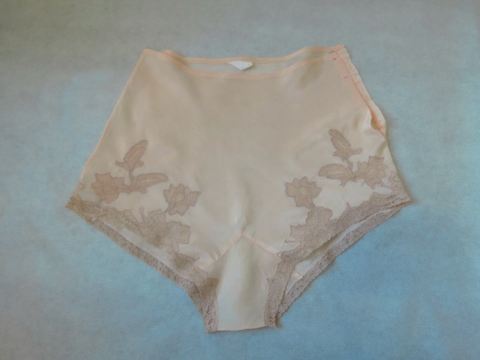
For many years, ladies’ undergarments have literally been “unmentionables”. Here, I’ll be focusing on the most unmentionable of unmentionables, the ladies’ knickers, tap pants or underpants!
Until fairly recently in history, women did not wear underpants at all! This is still the case in many cultures around the world. Wearing underpants did not become the norm for women until the early 19th century, when women began wearing long drawers.
During the Regency period, when women were wearing transparent muslin dresses, underwear became necessary for reasons of modesty. Originally, drawers were two separate legs that tied around the waist.
By Victorian times, split crotch drawers were the norm, with two separate legs joined on a waistband. The split crotch was a necessity when corsets and a multitude of petticoats encased a lady.

Towards the end of the 19th century and into the 20th century, drawers were sewn closed at the crotch. These drawers were often ornamented with tucks and lace, and generally closed on one or both hips with little mother of pearl shell buttons, or bone or ceramic buttons.

These drawers (below) are a particularly fine example of Edwardian or early 20th century drawers. Notice that they are a fair bit shorter than Victorian drawers.

Here is the lace and pin-tucked trim detail.

By the 1920s, the hemlines of drawers were getting shorter, although they still reached far below the buttocks. Young women’s bloomers were starting to morph into French knickers or “tap pants”, which started to become fashionable towards the end of the decade and into the 1930s.
The signature constructions detail of the 1930s was the bias cut. This meant that garments — dresses, nightgowns, cami knickers or teddies and the popular tap pants — were cut on the cross grain of the fabric rather than on the normal straight grain.
Cutting a garment on the cross grain allowed garments to drape beautifully, enhancing the figure. It also allowed a comfortable degree of stretch when stretch fabrics were yet to be invented.
The 1930s French knickers or tap pants cut on the cross generally closed at the hip with little shell buttons. Elastic was not necessary with bias cut garments.
These tap pants (below) are a rare example of floral silk knickers from the 1930s.


This pair of 1930s French knickers (below) is made from a beautiful silk organza fabric with a bamboo design, very unusual and beautiful.


Man-made fabrics were starting to be used for lingerie in the 1920s and more often in the 1930s. These underpants (below) are an acetate. It seems that not everyone wanted to wear the wide-legged French knickers, and this more modern look was introduced. These panties still opened on one hip and closed with a button, however.

In the US, the term tap pants is generally used. This possibly dates back to the 1930s’ and 1940s’ custom of dancers wearing shorts resembling these underpants at tap-dancing rehearsals.
In the 1940s, due to wartime restrictions, silk was not available, as it had been requisitioned for making parachutes! Stretch fabrics became available — rayons and acetates — and rayon largely replaced silk for underwear.
Nylon had been invented in the 1930s but was not available commercially until the 1940s, when it too was largely requisitioned for the war effort.
Luxury items were frowned upon as excess in times of such shortages, and there were even limits on what percentage of a garment could be embroidered!
By the early 1950s, femininity returned to fashion. Wartime rationing was mostly over and pretty lacy unmentionables were back.
These (below) have beautiful lace insertion and applique work. These are an early kind of nylon with a crepey feel. Note that the side opening has by now disappeared, replaced by the elastic waist.


During the 1950s, the French knickers, tap pants, or “scanties” as they were called in Australia, disappeared, replaced by more modern high-waisted full panties.
This hybrid pair of panties (below) has the look of short-legged French knickers, still with loose legs. Note the beautiful lace insertion work. Underwear like this was most likely part of a woman’s “trousseau” — the special wardrobe she made or collected to take with her into marriage.

These panties (below) are a beautiful early nylon with a dainty pattern in the weave, with cotton lace to trim. These come as a set with the matching slip and camisole. This panty style continues into the 1960s, with nylon being the most popular fabric, along with cotton.

By the mid 1960s, of course, anything goes. Underwear did not often appear in black until the 1950s. Until then it was invariably in peach. In France and the US, black lingerie appeared earlier than in Britain and Australia.

I suspect these ruffly cuties (below) were originally the pants to a babydoll pyjama set, but how sweet!

Towards the end of the 1960s, women’s underpants progressively became smaller and smaller — from the bikini panties in the 1970s, down to the g-string or “thong” in the 1990s.
Now, it seems, you can take your choice of any, with underpants available in any height and leg style. It can be almost as complicated as buying jeans!